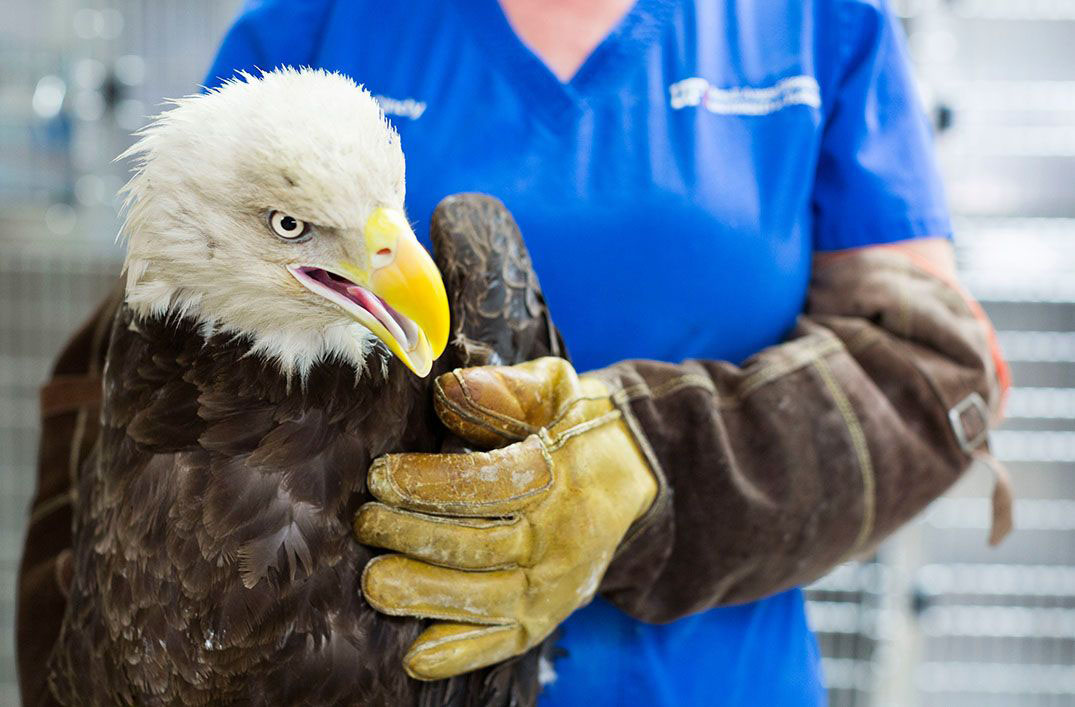
At the end of a row of enclosures, a bald eagle named Ziti is having breakfast. Today’s entrée is a rat stuffed with her morning medications — her second favorite meal, after fish.
It’s March 31, and Ziti is getting a new neighbor.
Like Ziti, Sauvignon was found on the ground. Ziti’s issues were obvious: When she arrived at the University of Florida College of Veterinary Medicine on January 14, her wing was broken so badly that the shattered bone was exposed. Sauvignon is more of a mystery. Just five weeks old, he had been sitting in a driveway for 24 hours, weak and lethargic.
As they did for Ziti, UF’s zoological medicine team swung into action.
With funding from the Batchelor Foundation and the University of Florida Veterinary Hospitals, specialists, technicians, students and volunteers on the zoological medicine team give 500 animals a year a chance at recovery and re-introduction to the wild. They’ve treated many species of reptiles, mammals and birds found in Florida, from rattlesnakes to hummingbirds, even a few alligators. Their patients are often unglamorous: possums and squirrels and turkey vultures. But each year brings a dozen or so visits from America’s national bird.
Facing near-extinction in the 1970s, the American bald eagle has rebounded. With about 1,500 nesting pairs, Florida has one of the country’s largest populations of this federally protected species, but bald eagles still face threats. Some, like Ziti, are hit by cars. Some are poisoned by pollutants or crowded out by habitat loss. Others are shot, accidentally or on purpose, or shocked by power lines. At UF, sick and injured eagles get a chance to recover, students learn how to care for them and species like them, and researchers gain insights into the health of the larger ecosystem to help wildlife and people alike.
After ten weeks at UF, Ziti bears little resemblance to the broken bird the team first met. Her wing has healed, and a new, snow-white feather grows from her tail, which was ragged from dragging across the road after the accident.
Many wild animals brought to UF are so badly injured that they have to be euthanized. But X-rays revealed no additional fractures, and enough intact bone left to support a surgical repair. Ziti would get a second chance.
Under the supervision of zoological medicine clinicians Dr. Jim Wellehan and Dr. Amy Alexander, residents Dr. Kyle Donnelly and Dr. Jane Christman pinned Ziti’s wing back together, holding it in place with a metal and acrylic fixator on the outside of her wing until it could heal.
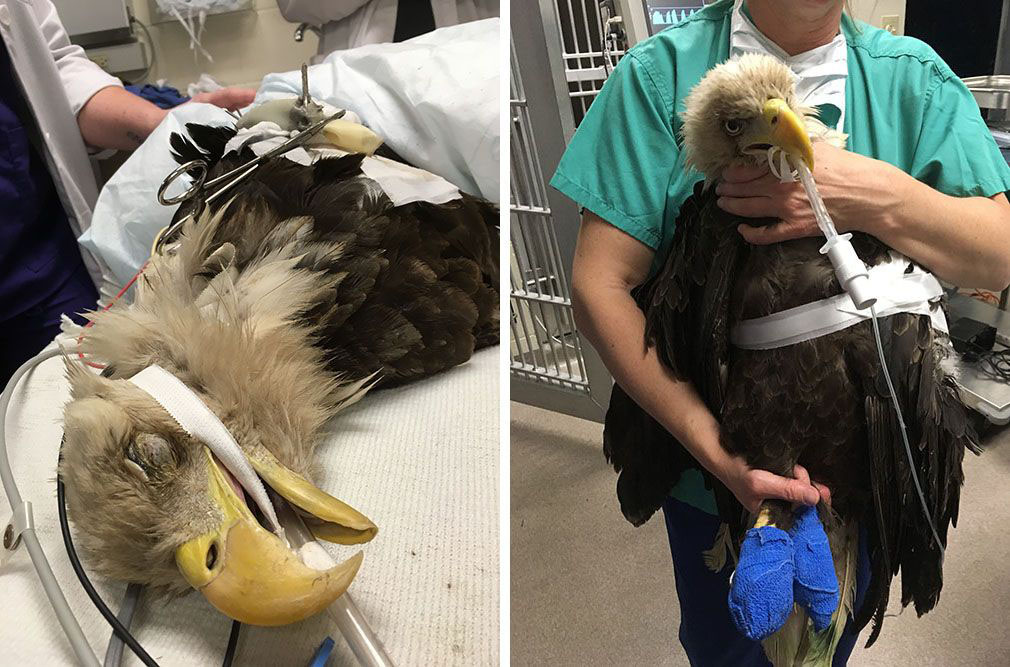
Ziti during and after surgery. "What the Gator Nation can do for wildlife is important, and it's appreciated," says eagle coordinator Resee Collins with the U.S. Fish and Wildlife Service. "They’re always just a phone call away when there's wildlife in need, and that’s something to be proud of." Photos courtesy of Kyle Donnelly.
Some eagles are laid back, happily taking the free meals and cooperating with treatments, says Resee Collins, who oversees eagle rehabilitation permits, including UF’s, for the southeast region of the U.S. Fish and Wildlife Service. “Others are more cantankerous,” she says. “You’ve got to love them: Those are the survivors.”
Ziti belongs squarely in the latter category.
“She has a very sassy personality, which is what we want,” Christman says after the surgery. “We don’t want eagles to be snuggly.”
Sauvignon — young, thin and crawling with parasites — was too sluggish to be sassy. The team cleaned him up, fed him and ordered blood tests and x-rays to pinpoint the cause of his weakness. Despite their caché as America’s national bird, eagles are happy to scavenge, points out zoological medicine service chief Dr. Darryl Heard. Sometimes their issues stem from eating lead-contaminated carcasses left by hunters. Others get sick from snacking at landfills. One eagle brought in from a landfill slept for days, which Heard says could have been caused by eating a euthanized animal that wasn’t disposed of properly. (See sidebar below for tips on what you can do to protect eagles from pollutants and other hazards.)
While some eagles just need a safe place to sleep it off, Ziti required more intervention. After her first surgery, the team noticed that her scab wasn’t healing as expected. That led them to suspect infection, so they went back in and removed some damaged tissue. This time, she healed up beautifully. The fixator came off and the glorious new tailfeather grew in. Physical therapists helped her regain her range of motion and the integrative medicine team used cold laser therapy to speed her healing.
Ziti was on the mend.
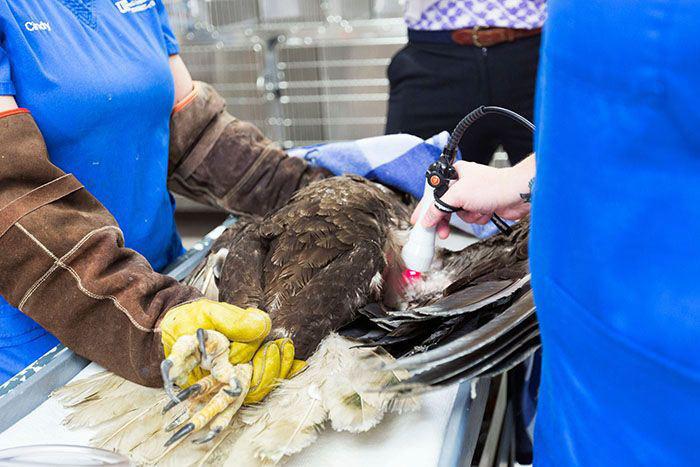
Ziti gets cold laser therapy to help heal her surgically repaired wing. Wildlife represents a third of the zoological medicine team's cases – they also see exotic pets and animals from zoos, attractions and conservation organizations. Photos by Brianne Lehan/UF Photography.
At this point, you might wonder: Why all this time and effort for one animal?
“People will make that comment until they run into an injured animal, or their children bring one to them,” says Collins, who has overseen more than 60 bald eagles treated at UF since the start of its rehab program in 2000. “You could consider it a civic duty. This is wildlife that belongs to all of us.”
Eagles are also part of a healthy environment that supports the leading industry — tourism — and quality of life in the nation’s third largest state, which is also the world’s 19th largest economy.
“Every single eagle that UF has had a hand in returning back to wild is helping to contribute to the wild population of eagles for everyone,” Collins says.
The students who work with wildlife will carry that knowledge throughout their careers, understanding not just how to help wild creatures, but what wildlife can tell us about the environment that sustains us.
“Wildlife health lets us peek into larger themes that affect all of us,” says Donnelly, whose research focuses on population health. The more UF researchers can learn about what’s impacting their wildlife patients, she explains, the more they know about emerging issues that can affect the entire ecosystem, including people. Wellehan, for example, identified a new pathogen affecting Florida tortoises by studying the wildlife patients brought to UF for medical help.
Pulitzer Prize-winning author Jack Davis, a UF history professor, points out another reason that eagles deserve our help. Davis, whose next book is about bald eagles (see sidebar), makes the case that since people are responsible for most of the injuries and illnesses that put eagles in the hospital, we have a moral duty to make amends. Until recently, he explained, scientists weren’t sure bald eagles would tolerate the kind of close contact we have with neighborhood wildlife like coyotes and raccoons.
But as they adapt to living alongside us, nesting in cell towers and snagging scraps from fishing boats, “eagles show us it’s possible to live peacefully with wildlife without sacrificing our standard of living or having to change our values dramatically,” he says. “Bald eagles have shown that they’re willing to live with us. We’ve got to show that we're willing to live with them as well.”
Sauvignon’s tests are back, but they haven’t shed any light on what brought him here. His bloodwork and x-rays are unremarkable.
A DNA test, however, has confirmed that he’s male, which the staff had guessed based on his size. Females are larger, which is why they assume Ziti, a large adult, is a she.
Even without answers, Sauvignon has gained weight and strength during his stay. He’s now looking like a gawky teenager, with black feathers sticking out from his head like spiked hair. (Bald eagles don’t get their signature white head for several years.) His eyes are still baby-eagle brown — they’ll change to yellow as he matures. The silliest part is the combination of his dark gray beak and yellow lips, which give him a clown smile he’ll sport until his beak changes to adult yellow in a few years.
Ziti, meanwhile, is looking every bit the resplendent national emblem. By early April, both eagles are ready to graduate to the Audubon Center for Birds of Prey in Maitland, Florida, where they’ll get flight training to rebuild their muscles in preparation for their return to the wild.
Sauvignon leaves first, on April 8. Ziti follows the next weekend. Christman, Ziti’s doctor, drives her to Audubon herself. The stakes are high: To make it in the wild, eagles have to fly well enough to hunt. If they can’t be re-released, their options are limited. As Heard explains, “If a zoo wants an eagle, chances are they already have one.”
At Audubon, Ziti gets a full exam and Christman gets a tour, checking out the roomy flight cages that will allow Ziti to get her strength back.
“I'm excited for her. This is the best possible place to succeed,” she says.
Twelve days later, tragedy struck. Ziti refractured her wing and had to be euthanized.
After Ziti’s death, Christman agonized over whether she should have done anything differently. Should she have kept her at UF longer, or did she keep her too long? Could the repair have been more solid?
“When something like this happens, it can be so discouraging. It makes you think, why do we do what we do? But things can't always be as happy and fuzzy as we want them to be. I've thought about it, and there isn't anything I would have done differently. We're all glad we gave her that opportunity. There isn't anything we could have done to change her outcome.”
Collins, the U.S. Fish and Wildlife coordinator, points out that while release into the wild is the ultimate goal, it’s not the only one. Necropsies of eagles that don’t survive add to our understanding of environmental threats the birds and other species face, such as poisoning from lead sinkers, which can be easily avoided if anglers opt for weights made of non-toxic materials. Eagles that die also get another life of sorts through the National Eagle Repository, which provides feathers to Native Americans and Alaskan Natives for religious and cultural ceremonies.
Sauvignon, however, has a different fate. After six weeks of rehab, he’s still geeky as hell, but he’s ready. On a Friday in May, he’s fitted with a tiny leather hood to keep him calm on his way to his new home, Princess Place Preserve in Flagler County. A nesting pair of eagles there has an eaglet almost exactly his age, and while it isn’t necessary to his survival, his rehabbers hope the pair might adopt him.
The hood comes off. He squints in the sun for a moment, then he flies.
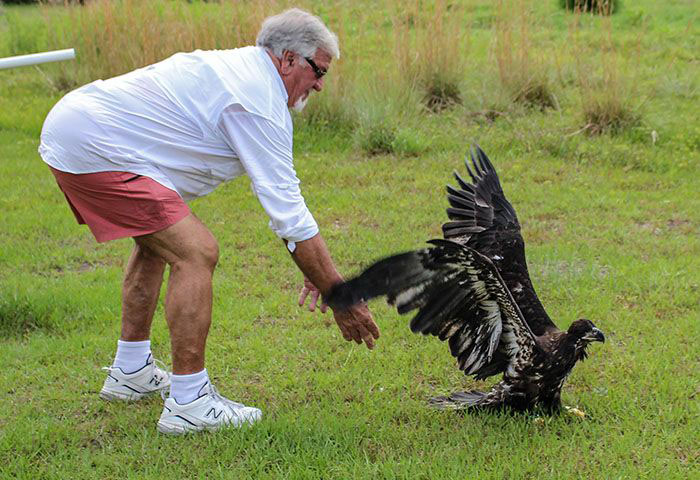
Sauvignon's release on May 18, 2018. Photos by Flagler County Public Information Officer Julie Murphy.
The next day, longtime volunteers with Audubon EagleWatch spot Sauvignon in a pine tree overlooking the Intracoastal Waterway. He looks “just fine,” the volunteer reported.
It was only one eagle. But it was so much more.
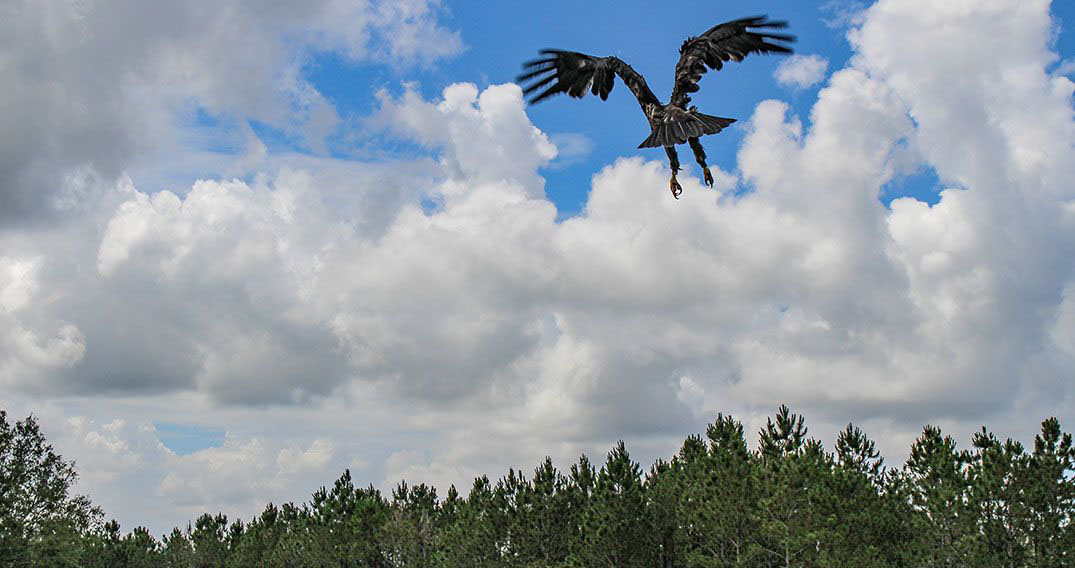
Sauvignon's release on May 18, 2018. Photos by Flagler County Public Information Officer Julie Murphy.
By Allisson Clark
On Eagles' Wings was originally published on the University of Florida website.